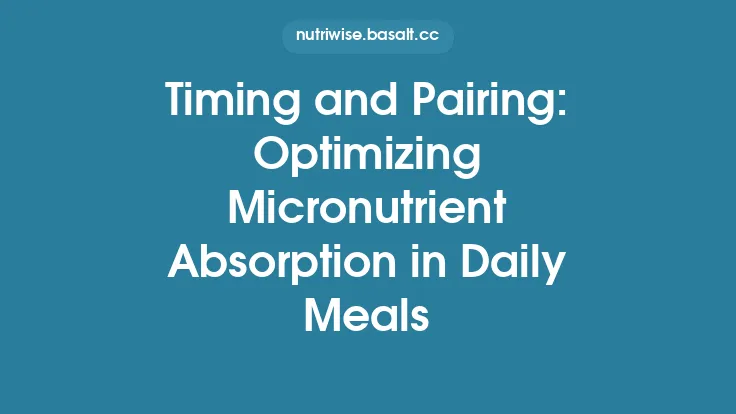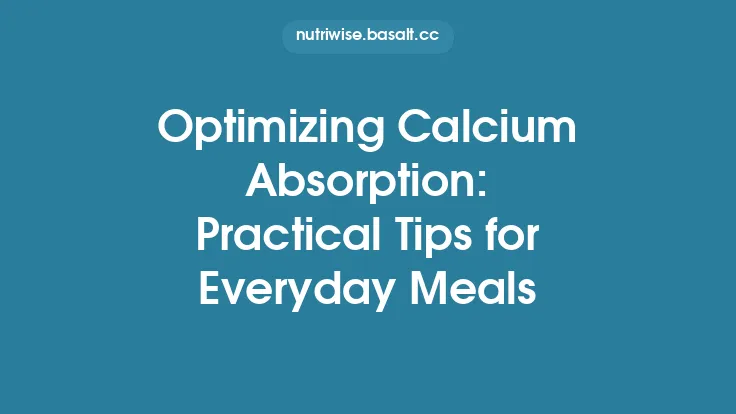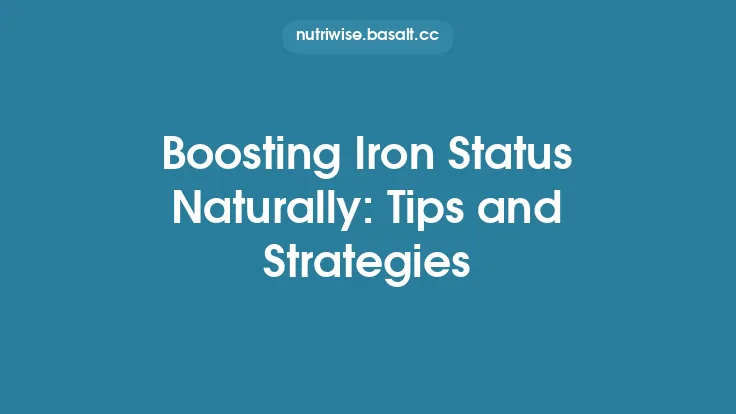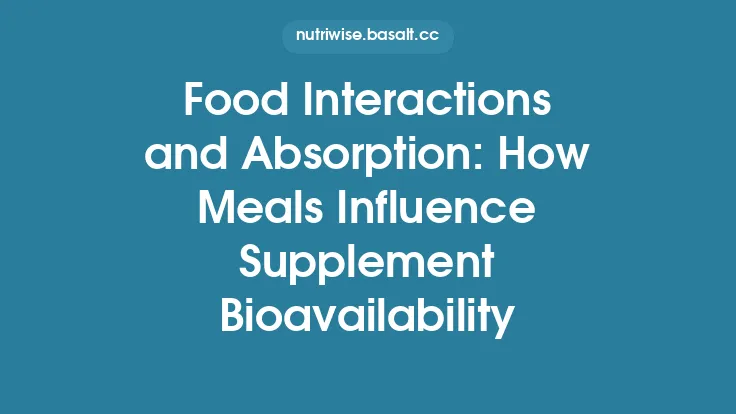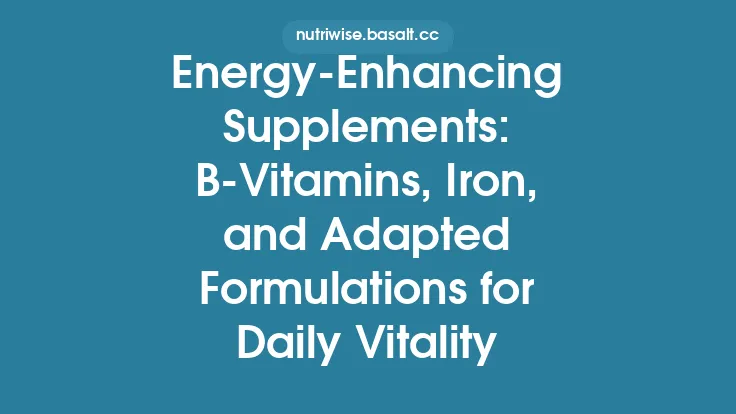Iron and calcium are two of the most essential minerals in the human diet, each playing distinct yet interrelated roles in health. Iron is pivotal for oxygen transport, cellular respiration, and enzymatic reactions, while calcium underpins bone mineralization, muscle contraction, nerve signaling, and blood clotting. Because both minerals share common transport pathways in the intestine and can influence each other’s absorption, the way they are presented together in a meal can markedly affect how much of each ultimately reaches the bloodstream. This article delves into the science behind their intestinal uptake and offers evidence‑based food‑pairing strategies that maximize the bioavailability of both minerals without compromising the other. By understanding the underlying mechanisms and applying practical pairing principles, consumers, clinicians, and food‑service professionals can design meals that support optimal iron and calcium status over the long term.
Mechanisms Governing Iron and Calcium Absorption
Iron absorption pathways
- Heme iron (from animal muscle and organ meats) is taken up intact via the heme carrier protein 1 (HCP1) on the apical membrane of duodenal enterocytes. Once inside the cell, heme oxygenase liberates ferrous iron (Fe²⁺).
- Non‑heme iron (the majority of dietary iron) must first be reduced from ferric (Fe³⁺) to ferrous form, a step catalyzed by duodenal cytochrome b (Dcytb). Ferrous iron then enters enterocytes through the divalent metal transporter‑1 (DMT1). Inside the cell, iron can be stored as ferritin or exported across the basolateral membrane via ferroportin, where it is re‑oxidized by hephaestin and bound to transferrin for systemic distribution.
Calcium absorption pathways
- Active transcellular transport dominates in the duodenum and proximal jejunum, especially when dietary calcium is low. Vitamin D‑dependent proteins—TRPV6 (apical calcium channel), calbindin‑D₉k (intracellular shuttle), and plasma membrane Ca²⁺‑ATPase (PMCA1b) on the basolateral side—coordinate the movement of calcium ions (Ca²⁺) into the bloodstream.
- Paracellular diffusion accounts for a substantial proportion of calcium uptake when intake is high, occurring through tight junctions that are modulated by the concentration gradient and the presence of certain anions (e.g., phosphate).
Points of interaction
Both iron and calcium can compete for DMT1, especially for non‑heme iron, because DMT1 transports a range of divalent cations. High luminal calcium concentrations can therefore reduce non‑heme iron uptake. Conversely, iron does not appear to significantly impede calcium’s paracellular route, but excessive iron may down‑regulate calcium‑transporting proteins indirectly through systemic hormonal feedback (e.g., fibroblast growth factor‑23). Understanding these shared transporters is the foundation for designing food pairings that minimize competition while leveraging synergistic effects.
Key Dietary Factors that Influence Their Interaction
| Factor | Effect on Iron | Effect on Calcium | Relevance to Pairing |
|---|---|---|---|
| Vitamin C (ascorbic acid) | Strong enhancer; reduces Fe³⁺ to Fe²⁺ and forms soluble complexes that resist precipitation. | Minimal direct effect; high doses may increase urinary calcium excretion but not absorption. | Pair vitamin C‑rich foods with non‑heme iron sources to boost iron without harming calcium. |
| Lactose | No significant impact. | Facilitates calcium solubility and may up‑regulate calcium‑transport proteins via a gut‑derived signaling cascade. | Include low‑fat dairy or fermented milk with calcium‑rich meals; does not hinder iron. |
| Organic acids (citric, malic, tartaric) | Form soluble iron‑organic acid complexes, enhancing absorption. | Chelate calcium, potentially improving its solubility in the small intestine. | Use citrus fruits or fruit‑based sauces to aid both minerals simultaneously. |
| Phytate (phytic acid) | Strong inhibitor; binds Fe³⁺ and forms insoluble complexes. | Also binds calcium, reducing its availability. | Reduce phytate content through soaking, sprouting, or fermentation before consumption. |
| Polyphenols (tannins, flavonoids) | Form insoluble iron complexes, especially with non‑heme iron. | Generally weak effect on calcium; some flavonoids may modestly inhibit calcium transport. | Limit high‑tannin beverages (tea, coffee) during iron‑rich meals; schedule them between meals. |
| Protein type | Heme‑protein (meat) provides readily absorbable iron; certain non‑heme proteins (e.g., whey) can modestly enhance iron uptake. | Dairy proteins (casein) can bind calcium but also increase its solubility; whey may improve calcium absorption. | Combine lean meat with dairy in balanced portions to support both minerals. |
Synergistic Food Pairings to Enhance Iron Uptake
- Red meat + Vitamin C‑rich fruit
- *Why it works*: Heme iron is already highly bioavailable, but the addition of vitamin C can further improve the absorption of any accompanying non‑heme iron (e.g., from marinades or side dishes).
- *Practical example*: Grilled steak served with a salsa of diced mango, red bell pepper, and lime juice.
- Poultry or fish + Fermented vegetables
- *Why it works*: Fermentation reduces phytate levels in vegetables, while lactic acid produced during fermentation acts as an organic acid that solubilizes iron.
- *Practical example*: Baked salmon with a side of kimchi or sauerkraut.
- Legume‑based dishes + Citrus dressing
- *Why it works*: Legumes are rich in non‑heme iron but also contain phytate. A citrus‑based vinaigrette (lemon or orange juice + olive oil) supplies vitamin C and citric acid, counteracting phytate’s inhibitory effect.
- *Practical example*: Chickpea salad tossed with a lemon‑olive‑oil dressing and chopped parsley.
- Whole‑grain cereals + Fruit puree
- *Why it works*: Whole grains provide iron, while fruit puree (e.g., apple or pear) delivers both vitamin C and malic acid, enhancing iron solubility.
- *Practical example*: Warm oatmeal topped with a spoonful of blueberry‑banana puree.
- Iron‑fortified plant milks + Vitamin C‑rich berries
- *Why it works*: Fortified milks often contain non‑heme iron bound to a carrier; adding berries supplies vitamin C that liberates the iron for absorption.
- *Practical example*: Almond milk fortified with iron, blended into a smoothie with strawberries and kiwi.
Food Pairings that Boost Calcium Bioavailability
- Dairy + Vitamin D‑rich foods
- *Why it works*: Vitamin D up‑regulates the expression of TRPV6, calbindin, and PMCA1b, enhancing active calcium transport.
- *Practical example*: Yogurt parfait layered with salmon flakes (a modest source of vitamin D) and a drizzle of honey.
- Leafy greens (low‑oxalate) + Lactose
- *Why it works*: Low‑oxalate greens such as bok choy provide calcium without the strong calcium‑oxalate binding seen in spinach. Lactose from a small amount of cheese can improve calcium solubility.
- *Practical example*: Stir‑fried bok choy with a sprinkle of grated Parmesan.
- Tofu (calcium‑set) + Citrus
- *Why it works*: Calcium‑set tofu delivers a high calcium load in a matrix that is readily digestible. Adding citrus (e.g., a squeeze of lime) supplies citric acid, which forms soluble calcium‑citrate complexes.
- *Practical example*: Silken tofu marinated in lime‑ginger sauce, served cold as an appetizer.
- Nuts & seeds + Fermented dairy
- *Why it works*: Almonds and sesame seeds are calcium‑rich but contain phytic acid. Consuming them with fermented dairy (e.g., kefir) provides probiotic activity that can degrade phytate, while the dairy’s calcium‑binding proteins keep calcium in solution.
- *Practical example*: A snack bowl of roasted almonds, pumpkin seeds, and a side of kefir.
- Fortified orange juice + Calcium‑rich cereals
- *Why it works*: Fortified orange juice supplies both vitamin C (which can aid iron) and calcium. When paired with calcium‑fortified cereals, the overall calcium load is increased, and the acidic environment helps keep calcium soluble.
- *Practical example*: A bowl of calcium‑fortified bran cereal topped with a splash of fortified orange juice.
Balancing Iron and Calcium in the Same Meal
Because high calcium concentrations can impede non‑heme iron absorption via competition for DMT1, careful timing and portion control are essential when both minerals are present in a single meal. The following guidelines help achieve a harmonious balance:
| Strategy | Implementation | Rationale |
|---|---|---|
| Separate high‑calcium and high‑non‑heme‑iron foods by ≥30 min | Serve a calcium‑rich dairy product (e.g., cheese) as a separate course before or after a plant‑based iron dish. | Allows DMT1 to operate without immediate calcium competition. |
| Use calcium‑rich foods with low phytate and low calcium‑oxalate | Choose dairy, calcium‑set tofu, or low‑oxalate greens rather than high‑oxalate vegetables when iron is also a focus. | Reduces the need for large calcium doses that could outcompete iron. |
| Incorporate strong iron enhancers (vitamin C, organic acids) when calcium is present | Add citrus vinaigrette to a mixed salad that includes both kale (calcium) and lentils (iron). | Vitamin C can offset calcium’s inhibitory effect on non‑heme iron. |
| Limit calcium supplement timing to between meals | Take calcium tablets at least two hours after iron‑rich meals. | Minimizes direct luminal competition. |
| Modulate portion size of calcium‑dense foods | Keep calcium‑rich side dishes to ≤½ cup per main meal when the main protein is a non‑heme iron source (e.g., beans). | Prevents excessive calcium concentrations that could saturate DMT1. |
Practical Meal Planning and Timing Strategies
- Breakfast – *Iron‑focused*:
- Whole‑grain toast topped with mashed avocado (non‑heme iron) and a side of orange slices (vitamin C).
- Follow with a low‑fat yogurt (calcium) after a 30‑minute interval.
- Mid‑morning snack – *Calcium‑focused*:
- A small serving of kefir mixed with a handful of berries (provides calcium and a modest vitamin C boost without overwhelming iron).
- Lunch – *Balanced*:
- Grilled chicken breast (heme iron) with a quinoa‑and‑black‑bean salad dressed in lime‑coriander vinaigrette (vitamin C, citric acid).
- Add a side of steamed bok choy sprinkled with toasted sesame seeds (calcium).
- Afternoon snack – *Iron enhancer*:
- A smoothie of fortified soy milk, frozen strawberries, and a scoop of whey protein (provides iron‑binding peptides that may aid absorption).
- Dinner – *Calcium‑rich*:
- Baked salmon (source of vitamin D) served with a creamy cauliflower puree made with a modest amount of low‑fat cheese.
- Pair with a small mixed green salad dressed with apple cider vinegar (organic acid).
- Evening – *Optional supplement timing*:
- If a calcium supplement is needed, take it at least two hours after the dinner meal, preferably before bedtime.
Special Considerations for Different Populations
- Pregnant and lactating women: Iron requirements increase dramatically (≈27 mg/day). Pairing iron‑rich foods with vitamin C at each main meal is especially critical. Calcium needs also rise (≈1,000 mg/day), but timing calcium supplements away from iron‑rich meals helps maintain both mineral balances.
- Older adults: Diminished gastric acid secretion can impair non‑heme iron reduction. Including fermented foods (which provide pre‑reduced iron) and modest amounts of heme meat can compensate. Calcium absorption efficiency also declines; pairing calcium sources with vitamin D‑rich foods (e.g., fortified dairy, fatty fish) is advisable.
- Vegetarians and vegans: Reliance on non‑heme iron makes vitamin C pairing indispensable. Calcium can be obtained from fortified plant milks, calcium‑set tofu, and low‑oxalate leafy greens. Soaking and sprouting legumes before cooking reduces phytate, further supporting both minerals.
- Athletes: High sweat losses increase calcium excretion. Including dairy or fortified alternatives post‑exercise, along with an iron‑rich snack containing vitamin C, can replenish both minerals efficiently.
Potential Pitfalls and How to Avoid Them
| Pitfall | Why it Happens | Mitigation |
|---|---|---|
| Consuming tea or coffee with iron‑rich meals | Tannins bind iron, forming insoluble complexes. | Schedule tea/coffee at least one hour before or after iron‑containing meals. |
| Over‑reliance on high‑oxalate greens for calcium | Oxalate forms calcium oxalate, a poorly absorbed precipitate. | Favor low‑oxalate greens (bok choy, kale) or pair high‑oxalate greens with vitamin D‑rich foods to improve calcium uptake. |
| Taking calcium supplements concurrently with iron‑fortified cereals | Direct competition at DMT1 reduces non‑heme iron absorption. | Separate supplement intake by 2–3 hours from fortified cereal consumption. |
| Excessive phytate intake without processing | Phytate chelates both iron and calcium. | Apply soaking, sprouting, or fermentation to grains, legumes, and nuts before cooking. |
| Neglecting vitamin D status | Vitamin D deficiency down‑regulates calcium transport proteins. | Ensure regular sunlight exposure or include vitamin D‑fortified foods/supplements, especially for older adults. |
Future Directions in Research and Application
- Targeted food‑matrix engineering – Emerging technologies such as microencapsulation and controlled‑release emulsions aim to spatially separate calcium and iron within a single product, allowing simultaneous consumption without competitive inhibition.
- Personalized nutrition algorithms – Integrating genetic markers (e.g., HFE mutations affecting iron metabolism) with dietary intake data could generate individualized pairing recommendations that optimize both minerals for each person.
- Gut‑derived peptide modulators – Recent studies suggest that certain bioactive peptides released during protein digestion can up‑regulate DMT1 or calcium‑transport proteins. Formulating meals to maximize these peptide yields may become a novel strategy for enhancing mineral absorption.
- Real‑time monitoring of mineral status – Non‑invasive sensors capable of measuring serum ferritin or ionized calcium in near‑real time could provide immediate feedback on the effectiveness of specific food pairings, enabling rapid dietary adjustments.
- Sustainable sourcing of bioavailable minerals – As plant‑based diets expand, research into biofortified crops (e.g., iron‑enhanced beans with low phytate) and calcium‑rich algae offers promising avenues to meet global mineral needs without compromising absorption.
By applying the mechanistic insights and practical pairing principles outlined above, it is possible to design meals that simultaneously support robust iron and calcium status. Thoughtful selection of complementary foods, strategic timing, and awareness of inhibitory factors empower individuals to harness the full nutritional potential of their diet, fostering long‑term skeletal health, optimal oxygen transport, and overall physiological resilience.
